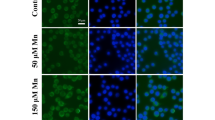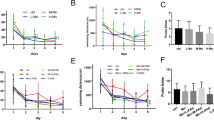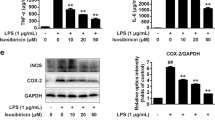Abstract
Background
Sodium p-aminosalicylic acid (PAS-Na) was reported to exhibit anti-inflammatory effect in the nervous system. However, the mechanism by which PAS-Na exhibits anti-inflammatory effects on manganese (Mn)-stimulated BV2 microglia cells remains unclear. Thus, this study investigated the role of PAS-Na in Mn-stimulated BV2 microglial cells.
Methods
Microglia-like BV2 were treated with MnCl2 with or without the non-steroidal anti-inflammatory drug PAS-Na for 12 or 24 h to examine cell viability using MTT; for 24 or 48 h to examine levels of NLRP3, CASP1, IL-1β, and IL-18 mRNA using Real-Time quantitative PCR; for 48 h to examine levels of NLRP3 and CASP1 inflammasomes, measured by western blot analysis; and for 48 h to examine levels of inflammatory cytokines, measured by enzyme-linked immunosorbent assay.
Results
The MTT assay showed that PAS-Na produced significant neuroprotective effect by preventing Mn-induced inflammation in BV2 microglial cells. PAS-Na significantly concentration and time dependently inhibited Mn-induced production of NLRP3, CASP1, IL-1β, and IL-18.
Conclusion
Taken together, our results suggest that PAS-Na exerts anti-inflammatory effects in Mn-stimulated BV2 microglial cells via downregulation of NLRP3, CASP1, IL-1β, and I L-18. Furthermore, a high concentration and prolonged PAS-Na treatment appear necessary for its therapeutic efficacy. Taken together, we conclude that PAS-Na affords therapeutic efficacy in mitigating neurological conditions associated with neuroinflammation.







Similar content being viewed by others
Data Availability
All data generated or analyzed during this study are included in this published article.
Abbreviations
- Mn:
-
manganese
- PD:
-
Parkinson’s disease
- AD:
-
Alzheimer’s disease
- CNS:
-
central nervous system
- IL1β:
-
interleukin 1 β
- IL18:
-
interleukin 18
- NLRP3:
-
NLR family, pyrin domain containing 3
- CASP1:
-
caspase-1
- PAS-Na:
-
sodium p-aminosalicylic acid
- qPCR:
-
quantitative real-time polymerase chain reaction
- ELISA:
-
enzyme-linked immunosorbent assay
References
Aschner JL, Aschner M (2005) Nutritional aspects of manganese homeostasis. Mol Asp Med 26(4-5):353–362. https://doi.org/10.1016/j.mam.2005.07.003
Wang D, Zhang J, Jiang W, Cao Z, Zhao F, Cai T, Aschner M, Luo W (2017) The role of NLRP3-CASP1 in inflammasome-mediated neuroinflammation and autophagy dysfunction in manganese-induced, hippocampal-dependent impairment of learning and memory ability. Autophagy 13(5):914–927. https://doi.org/10.1080/15548627.2017.1293766
Martinez-Finley EJ, Gavin CE, Aschner M, Gunter TE (2013) Manganese neurotoxicity and the role of reactive oxygen species. Free Radic Biol Med 62:65–75. https://doi.org/10.1016/j.freeradbiomed.2013.01.032
Tuschl K, Mills PB, Clayton PT (2013) Manganese and the brain. Int Rev Neurobiol 110:277–312. https://doi.org/10.1016/b978-0-12-410502-7.00013-2
Kim J, Pajarillo E, Rizor A, Son DS, Lee J, Aschner M, Lee E (2019) LRRK2 kinase plays a critical role in manganese-induced inflammation and apoptosis in microglia. PLoS One 14(1):e0210248. https://doi.org/10.1371/journal.pone.0210248
Langley MR, Ghaisas S, Ay M, Luo J, Palanisamy BN, ** H, Anantharam V, Kanthasamy A, Kanthasamy AG (2018) Manganese exposure exacerbates progressive motor deficits and neurodegeneration in the MitoPark mouse model of Parkinson’s disease: relevance to gene and environment interactions in metal neurotoxicity. Neurotoxicology 64:240–255. https://doi.org/10.1016/j.neuro.2017.06.002
Ijomone OM, Aluko OM, Okoh COA, Martins AC Jr, Aschner M (2019) Role for calcium signaling in manganese neurotoxicity. J Trace Elem Med Biol 56:146–155. https://doi.org/10.1016/j.neuro.2017.06.002
Yin L, Dai Q, Jiang P, Zhu L, Dai H, Yao Z, Liu H, Ma X, Qu L, Jiang J (2018) Manganese exposure facilitates microglial JAK2-STAT3 signaling and consequent secretion of TNF-a and IL-1β to promote neuronal death. Neurotoxicology 64:195–203. https://doi.org/10.1016/j.neuro.2017.04.001
Crittenden PL, Filipov NM (2008) Manganese-induced potentiation of in vitro proinflammatory cytokine production by activated microglial cells is associated with persistent activation of p38 MAPK. Toxicol in Vitro 22(1):18–27. https://doi.org/10.1016/j.tiv.2007.07.004
Abe H, Ohishi T, Nakane F, Shiraki A, Tanaka T, Yoshida T, Shibutani M (2015) Exposure to MnCl2 . 4H2O during development induces activation of microglial and perivascular macrophage populations in the hippocampal dentate gyrus of rats. J Appl Toxicol 35(5):529–535. https://doi.org/10.1002/jat.3059
Colonna M, Butovsky O (2017) Microglia function in the central nervous system during health and neurodegeneration. Annu Rev Immunol 35:441–468. https://doi.org/10.1146/annurev-immunol-051116-052358
Kabba JA, Xu Y, Christian H, Ruan W, Chenai K, **ang Y, Zhang L, Saavedra JM, Pang T (2018) Microglia: housekeeper of the central nervous system. Cell Mol Neurobiol 38(1):53–71. https://doi.org/10.1007/s10571-017-0504-2
Kirkley KS, Popichak KA, Afzali MF, Legare ME, Tjalkens RB (2017) Microglia amplify inflammatory activation of astrocytes in manganese neurotoxicity. J Neuroinflammation 14(1):99. https://doi.org/10.1186/s12974-017-0871-0
Kraft AD, Harry GJ (2011) Features of microglia and neuroinflammation relevant to environmental exposure and neurotoxicity. Int J Environ Res Public Health 8(7):2980–3018. https://doi.org/10.3390/ijerph8072980
Sarkar S, Rokad D, Malovic E, Luo J, Harischandra DS, ** H, Anantharam V, Huang X, Lewis M, Kanthasamy A, Kanthasamy AG (2019) Manganese activates NLRP3 inflammasome signaling and propagates exosomal release of ASC in microglial cells. Sci Signal 12(563):eaat9900. https://doi.org/10.1126/scisignal.aat9900
Chen J, Su P, Luo W, Chen J (2018) Role of LRRK2 in manganese-induced neuroinflammation and microglial autophagy. Biochem Biophys Res Commun 498(1):171–177. https://doi.org/10.1016/j.bbrc.2018.02.007
Tjalkens RB, Popichak KA, Kirkley KA (2017) Inflammatory activation of microglia and astrocytes in manganese neurotoxicity. Adv Neurobiol 18:159–181
Parvez MM, Shin HJ, Jung JA, Shin JG (2017) Evaluation of para-aminosalicylic acid as a substrate of multiple solute carrier uptake transporters and possible drug interactions with nonsteroidal anti-inflammatory drugs in vitro. Antimicrob Agents Chemother 61(5). https://doi.org/10.1128/AAC.02392-16
Zheng W, Jiang YM, Zhang Y, Jiang W, Wang X, Cowan DM (2009) Chelation therapy of manganese intoxication with para-aminosalicylic acid (PAS) in Sprague–Dawley rats. NeuroToxicology 30(2):240–248. https://doi.org/10.1016/j.neuro.2008.12.007
Jiang YM, Mo XA, Du FQ, Fu X, Zhu XY, Gao HY, **e JL, Liao FL, Pira E, Zheng W (2006) Effective treatment of manganese-induced occupational Parkinsonism with p-aminosalicylic acid: a case of 17-year follow-up study. J Occup Environ Med 48(6):644–649. https://doi.org/10.1097/01.jom.0000204114.01893.3e
Du QF, Mo XA, Jiang YM, Fu X, Gao HY, Liao FL (2008) A 17-year follow-up observation on a case of effective treatment of severe chronic manganese intoxication with p-aminosalicylic acid [in Chinese]. Chin Occup Med 35(5):398–399
Ky S, Deng H, **e P, Hu W (1992) A report of two cases of chronic serious manganese poisoning treated with sodium para-aminosalicylic acid. Br J Ind Med 49(1):66–69. https://doi.org/10.1136/oem.49.1.66
Ky SQ, Hu WD, Jiang YM, Wei XM, Huang B, Hong XJ, Ge LH, Guo JX, Huang CP (1995) Sodium P-aminosalicylic acid of mechanism in treating chronic manganese poisoning [in Chinese]. J Guangxi Med Univ (04):477–483. https://doi.org/10.16190/j.cnki.45-1211/r.1995.04.001
Li SJ, Qin WX, Peng DJ, Yuan ZX, He SN, Luo YN, Aschner M, Jiang YM, Liang DY, **e BY, Xu F (2018) Sodium P-aminosalicylic acid inhibits sub-chronic manganese-induced neuroinflammation in rats by modulating MAPK and COX-2. Neurotoxicology 64:219–229. https://doi.org/10.1016/j.neuro.2017.06.012
Li SJ, Li Y, Chen JW, Yuan ZX, Mo YH, Lu GD, Jiang YM, Ou CY, Wang F, Huang XW, Luo YN, Ou SY, Huang YN (2016) Sodium para-aminosalicylic acid protected primary cultured basal ganglia neurons of rat from manganese-induced oxidative impairment and changes of amino acid neurotransmitters. Biol Trace Elem Res 170(2):357–365. https://doi.org/10.1007/s12011-015-0472-7
Ou CY, Luo YN, He SN, Deng XF, Luo HL, Yuan ZX, Meng HY, Mo YH, Li SJ, Jiang YM (2016) Sodium P-aminosalicylic acid improved manganese-induced learning and memory dysfunction via restoring the ultrastructural alterations and γ-aminobutyric acid metabolism imbalance in the basal ganglia. Biol Trace Elem Res 176(1):143–153. https://doi.org/10.1007/s12011-016-0802-4
Peng DJ, Zhang YW, Li ZC, Li SJ, Cai M, Qin WX, Ou SY, Huang XW, Yuan ZX, Jiang YM (2019) Preventive impacts of PAS-Na on the slow growth and activated inflammatory responses in Mn-exposed rats. J Trace Elem Med Biol 54:134–141. https://doi.org/10.1016/j.jtemb.2019.04.013
Crossgrove J, Zheng W (2004) Manganese toxicity upon overexposure. NMR Biomed 17(8):544–553. https://doi.org/10.1002/nbm.931
Ward RJ, Crichton RR (2019) Manganese: its role in disease and health. Met Ions Life Sci 19. https://doi.org/10.1515/9783110527872-010
Dickerson RN (2001) Manganese intoxication and parenteral nutrition. Nutrition 17(7-8):689–693. https://doi.org/10.1016/s0899-9007(01)00546-9
Nizami S, Hall-Roberts H, Warrier S, Cowley SA, Di Daniel E (2014) Thalamic GABA predicts fine motor performance in manganese-exposed smelter workers. PLoS One 9(2):3515–3532. https://doi.org/10.1111/bph.14618
Wang H, Yang F, **n R, Cui D, He J, Zhang S, Sun Y (2020) The gut microbiota attenuate neuroinflammation in manganese exposure by inhibiting cerebral NLRP3 inflammasome. Biomed Pharmacother 129:110449. https://doi.org/10.1016/j.biopha.2020.110449
Tang Y, Le W (2016) Differential roles of M1 and M2 microglia in neurodegenerative diseases. Mol Neurobiol 53(2):1181–1194. https://doi.org/10.1007/s12035-014-9070-5
Liu M, Cai T, Zhao F, Zheng G, Wang Q, Chen Y, Huang C, Luo W, Chen J (2009) Effect of microglia activation on dopaminergic neuronal injury induced by manganese, and its possible mechanism. Neurotox Res 16(1):42–49. https://doi.org/10.1007/s12640-009-9045-x
Filipov NM, Dodd CA (2012) Role of glial cells in manganese neurotoxicity. J Appl Toxicol 32(5):310–317. https://doi.org/10.1002/jat.1762
Zhao F, Cai T, Liu M, Zheng G, Luo W, Chen J (2009) Manganese induces dopaminergic neurodegeneration via microglial activation in a rat model of manganism. Toxicol Sci 107(1):156–164. https://doi.org/10.1093/toxsci/kfn213
Jo EK, Kim JK, Shin DM, Sasakawa C (2016) Molecular mechanisms regulating NLRP3 inflammasome activation. Cell Mol Immunol 13(2):148–159. https://doi.org/10.1038/cmi.2015.95
Heneka MT, Kummer MP, Latz E (2014) Innate immune activation in neurodegenerative disease. Nat Rev Immunol 14(7):463–477. https://doi.org/10.1038/nri3705
Takahashi M (2019) Role of NLRP3 inflammasome in cardiac inflammation and remodeling after myocardial infarction. Biol Pharm Bull 42(4):518–523. https://doi.org/10.1248/bpb.b18-00369
Zhong Z, Sanchez-Lopez E, Karin M (2016) Autophagy, NLRP3 inflammasome and auto-inflammatory/immune diseases. Clin Exp Rheumatol 34(4 Suppl 98):12–16
Hui B, Zhang L, Zhou Q, Hui L (2018) Pristimerin inhibits LPS-triggered neurotoxicity in BV-2 microglia cells through modulating IRAK1/TRAF6/TAK1-mediated NF-kappaB and AP-1 signaling pathways in vitro. Neurotox Res 33(2):268–283. https://doi.org/10.1007/s12640-017-9837-3
Li L, Sun Q, Li Y, Yang Y, Yang Y, Chang T, Man M, Zheng L (2015) Overexpression of SIRT1 induced by resveratrol and inhibitor of miR-204 suppresses activation and proliferation of microglia. J Mol Neurosci 56(4):858–867. https://doi.org/10.1007/s12031-015-0526-5
Nizami S, Hall-Roberts H, Warrier S, Cowley SA, Di Daniel E (2019) Microglial inflammation and phagocytosis in Alzheimer’s disease: potential therapeutic targets. Br J Pharmacol 176(18):3515–3532. https://doi.org/10.1111/bph.14618
Peng Z, Luchtman DW, Wang X, Zhang Y, Song C (2019) Activation of microglia synergistically enhances neurodegeneration caused by MPP(+) in human SH-SY5Y cells. Eur J Pharmacol 850:64–74. https://doi.org/10.1016/j.ejphar.2019.01.024
Kumar A, Chaudhary T, Mishra J (2013) Minocycline modulates neuroprotective effect of hesperidin against quinolinic acid induced Huntington’s disease like symptoms in rats: behavioral, biochemical, cellular and histological evidences. Eur J Pharmacol 720(1-3):16–28. https://doi.org/10.1016/j.ejphar.2013.10.057
Voet S, Srinivasan S, Lamkanfi M, van Loo G (2019) Inflammasomes in neuroinflammatory and neurodegenerative diseases. EMBO Mol Med 11(6). https://doi.org/10.15252/emmm.201810248
Sarlus H, Heneka MT (2017) Microglia in Alzheimer’s disease. J Clin Invest 127(9):3240–3249. https://doi.org/10.1172/JCI90606
Chu F, Shi M, Zheng C, Shen D, Zhu J, Zheng X, Cui L (2018) The roles of macrophages and microglia in multiple sclerosis and experimental autoimmune encephalomyelitis. J Neuroimmunol 318:1–7. https://doi.org/10.1016/j.jneuroim.2018.02.015
Santos AP, Lucas RL, Andrade V, Mateus ML, Milatovic D, Aschner M, Batoreu MC (2012) Protective effects of ebselen (Ebs) and para-aminosalicylic acid (PAS) against manganese (Mn)-induced neurotoxicity. Toxicol Appl Pharmacol 258(3):394–402. https://doi.org/10.1016/j.taap.2011.12.003
Kuwar R, Rolfe A, Di L, Xu H, He L, Jiang Y, Zhang S, Sun D (2019) A novel small molecular NLRP3 inflammasome inhibitor alleviates neuroinflammatory response following traumatic brain injury. J Neuroinflammation 16(1):81. https://doi.org/10.1186/s12974-019-1471-y
Boucher D, Monteleone M, Coll RC, Chen KW, Ross CM, Teo JL, Gomez GA, Holley CL, Bierschenk D, Stacey KJ, Yap AS, Bezbradica JS, Schroder K (2018) Caspase-1 self-cleavage is an intrinsic mechanism to terminate inflammasome activity. J Exp Med 215(3):827–840. https://doi.org/10.1084/jem.20172222
Gustin A, Kirchmeyer M, Koncina E, Felten P, Losciuto S, Heurtaux T, Tardivel A, Heuschling P, Dostert C (2015) NLRP3 inflammasome is expressed and functional in mouse brain microglia but not in astrocytes. PLoS One 10(6):e0130624. https://doi.org/10.1371/journal.pone.0130624
Schroder K, Tschopp J (2010) The inflammasomes. Cell 140(6):821–832. https://doi.org/10.1016/j.cell.2010.01.040
Acknowledgments
Thanks to the fund support provided by grants from the National Natural Science Foundation of China (NSFC 81460505, 81973094). MA was supported in part by a grant from the National Institute of Environmental Health Science (NIEHS) R01ES10563.
Author information
Authors and Affiliations
Contributions
YF, DP, and YL carried out the studies and drafted the manuscript. LL and SO assisted with the establishment of the cell model. JL, LZ, and MA performed the statistical analysis. YF, DP, YL, LL, SO, JL, and LZ took part in the sample preparation and experimental analysis. YJ and MA designed the study. YJ led the study. All authors read and approved the final manuscript.
Corresponding author
Ethics declarations
Competing Interests
The authors declare that they have no competing interests.
Additional information
Publisher’s Note
Springer Nature remains neutral with regard to jurisdictional claims in published maps and institutional affiliations.
Rights and permissions
About this article
Cite this article
Fang, Y., Peng, D., Liang, Y. et al. Sodium P-aminosalicylic Acid Inhibits Manganese-Induced Neuroinflammation in BV2 Microglial Cells via NLRP3-CASP1 Inflammasome Pathway. Biol Trace Elem Res 199, 3423–3432 (2021). https://doi.org/10.1007/s12011-020-02471-7
Received:
Accepted:
Published:
Issue Date:
DOI: https://doi.org/10.1007/s12011-020-02471-7




